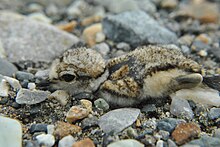River lapwing
| River lapwing | ||||||||||
|---|---|---|---|---|---|---|---|---|---|---|

River lapwing ( Vanellus duvaucelii ) |
||||||||||
| Systematics | ||||||||||
|
||||||||||
| Scientific name | ||||||||||
| Vanellus duvaucelii | ||||||||||
| ( Lesson , 1826) |
The river lapwing ( Vanellus duvaucelii ) is a species of bird belonging to the lapwing genus . It occurs in Southeast Asia . The art epithet honors the French naturalist Alfred Duvaucel .
features
The river lapwing reaches a size of 29.5 to 31.5 centimeters and a weight of 143 to 185 grams. The face is black. The eyes are red. The crown and neck feathers can be raised to form a hood. There are black spurs on the tarsus. From the closely related black lapwing ( Vanellus spinosus ), which occurs in Africa and the Middle East, it differs in its gray chest and the light gray sides of the head and neck. There is a small black spot on the stomach. The sexes look the same, but the males are slightly larger. In juvenile birds, the black head feathers have brown tips. The back is more tan than that of the adult birds and the feathers on the underside and the wing covers are characterized by light-colored hems.
Occurrence
The range of the river lapwing stretches from Uttar Pradesh and Nepal through eastern central India and northeastern India to southwestern Yunnan and Indochina .
habitat
The species can usually be found near rivers, especially on agricultural areas, on sandbanks and on gravel banks. It is rarely found in stagnant waters.
Way of life
The lapwing is usually true to location, but does seasonal nomadic migrations. The diet consists mainly of insects, worms, crustaceans and mollusks. Apparently frogs and tadpoles are also part of the diet. The breeding season is between March and June. Courtship behavior with four participating birds was observed twice. The nest is a shallow scrape on an exposed sand bar or gravel bar in the river. The clutch consists of three to four eggs, which are apparently incubated for 22 to 24 days.
status
The river lapwing is classified by BirdLife International in the “ Least Concern” category. The total population is quite small, arguably less than 25,000 individuals, and presumably no more than 15,000 specimens. Annual censuses never found more than 500 birds. It is not common in Thailand and appears to only be found in the northwest of the country.
literature
- Josep del Hoyo , Andrew Elliot, Jordi Sargatal : Handbook of the Birds of the World. Volume 3: Hoatzin to Auks. Lynx Edicions, Barcelona 1996, ISBN 8487334202 .
Web links
- Vanellus duvaucelii onthe IUCN 2013 Red List of Threatened Species . Listed by: BirdLife International, 2012. Retrieved December 7, 2013.
